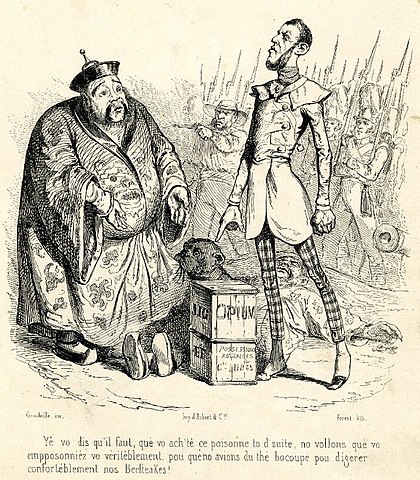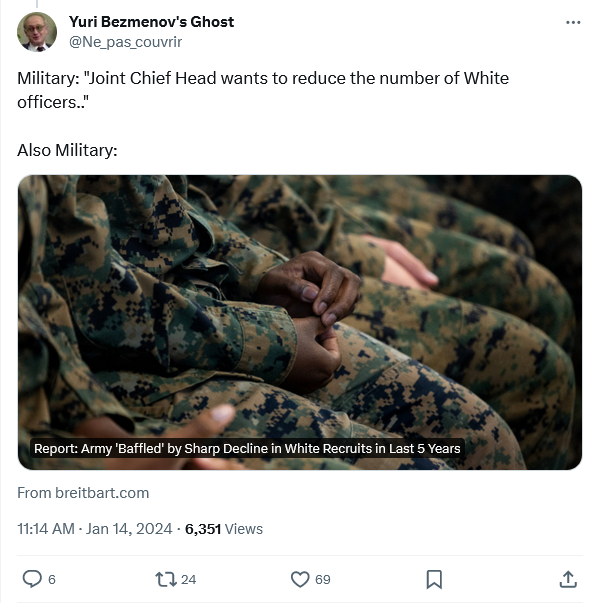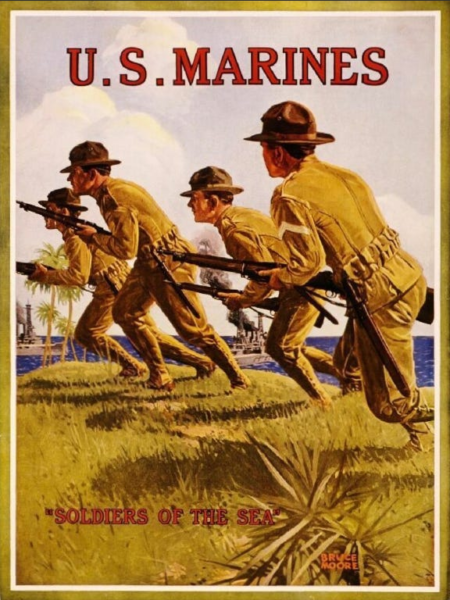The Great War
Published 11 Oct 2024The Mexican Revolution of 1910-1920 was a conflict of shifting alliances and assassinations, peasant revolutionaries, an attack on US soil, and US intervention in Mexico. The decade of struggle cost hundreds of thousands of lives, resulted in new constitutions and governments, and — for some at least — turned bandits into heroes.
(more…)
March 2, 2025
The Mexican Revolution – Bandits Turned Heroes
February 5, 2025
Trump tariff diary, day 4
The Big Orange Meanie and the Little Potato had a phone call, after which the BOM announced a 30-day delay to the imposition of tariffs. In Canada, all of “peoplekind” were relieved to hear that they won’t have to give up their American-made binkies quite yet. Some appropriate snark from The Free Press:

It was actually a phone call between the BOM and the Little Potato, but we can imagine this is what it would have looked like in person.
Mexican president Claudia Sheinbaum Speedy Gonzales’d her way to a deal with Trump yesterday, promising to deploy 10,000 Mexican troops to the border to stop the flow of illegal immigrants and drugs. In return, Trump agreed to pause his 25 percent tariff on goods coming from south of the border. Soon after, he struck a seemingly identical deal with Justin Trudeau, who said he’d appoint a “fentanyl czar” and promised to send 10,000 Canadian troops to the northern border. Who knew they even had that many?! Tariffs will still be levied against Chinese goods starting today, but Trump says he plans to talk with President Xi Jinping as soon as this week.
The FP isn’t wrong … the Canadian Army doesn’t have 10,000 spare troops just hanging around their barracks who could be sent to the border, so it’s much more likely to be a combination of Canadian Border Services Agency (CBSA) agents, RCMP officers, provincial police (if the respective provinces are willing), and whatever the army can spare. (Trudeau refers only to “nearly 10,000 frontline personnel”, not “troops” as a lot of US reports state … that seems a lot more achievable.)
You may be wondering how the US President has such disruptive and antagonistic tools at his disposal. It’s yet another hangover from the Carter years, as Congress delegated these powers to the president in 1977:
The emerging on-off-on-off trade war between Canada and the United States has everyone asking “How should we fight?” — understandably enough — but we should not move too quickly beyond the question “How is this literal nonsense at all possible?” How did the U.S. Congress’s clearly specified constitutional power to regulate the country’s commerce with foreign nations fall into naked and unapologetic decrepitude? Why is every new American president now a Napoleon, and why isn’t this at all a political issue in the U.S.?
The American Constitution, it seems, has no political party apart from a handful of cranky, tireless libertarians like Gene Healy, Clyde W. Crews or Ilya Somin, who has a new article spitballing possible litigation approaches for Americans who lie in the path of the tariffs now being wishcasted into existence by Napoleon the 47th. Somin explains that President Donald Trump is using an openly contrived “national emergency” to invoke powers delegated to the White House by Congress in 1977, powers that are to be invoked only in the face of “unusual and extraordinary threats” to the Republic.
Since the president apparently has plenary power to define an emergency, and to do so without offering anything resembling a rational explanation, this act of Congress now appears to be less of a delegation and more of a surrender — a total abandonment of constitutional principle and the classical separation of powers. I pause to observe that the cheeks every Canadian should redden with slight shame at the spectacle of frivolous recourse to the law of emergencies causing obvious and sickening injury to the rule of law in the U.S. (Oh, no, that could never happen here!)
August 28, 2024
H.R. McMaster dishes on Trump’s first term in office
In Reason, Liz Wolfe covers some of the head-scratchers former National Security Advisor H.R. McMaster revealed about working for Donald Trump:

Donald Trump addresses a rally in Nashville, TN in March 2017.
Photo released by the Office of the President of the United States via Wikimedia Commons.
What might a second Trump White House be like? In his new book, At War with Ourselves: My Tour of Duty in the Trump White House, Lt. Gen. H.R. McMaster, who served as national security adviser to Donald Trump (for one year), characterizes Oval Office meetings as “exercises in competitive sycophancy” where advisers would greet him with lines like “your instincts are always right” or “no one has ever been treated so badly by the press”.
Trump, meanwhile, would come up with crazy concepts, and float them: “Why don’t we just bomb the drugs?” (Also: “Why don’t we take out the whole North Korean Army during one of their parades?”)
This is one man’s account, of course. McMaster’s word should not be taken as gospel, and some of his frustration might stem from his dismissal, or his foreign-policy prescriptions being at times ignored by his boss. But it’s a somewhat revealing look behind the curtain at policy-setting in a White House helmed by an especially mercurial commander in chief, who “enjoyed and contributed to interpersonal drama in the White House and across the administration”.
It also shows how quickly Trump fantasies have percolated through the Republican Party, namely the “let’s just bomb Mexico to get rid of the cartels” line, which Trump has been toying with since roughly 2019 (or possibly more like 2017, after he chatted with Rodrigo Duterte, former president of the Philippines, who had promised to kill 100,000 drug traffickers during his first six months as president). A few years prior, in 2015, he had suggested that Mexico was sending rapist and drug-traffickers across the southern border, and that we’d need to build a wall between the two countries, but it wasn’t until nine American citizens were killed in Mexico that Trump trotted out the idea of declaring cartels foreign terrorist organizations and using military might to eradicate them.
Trump’s line from 2019 has now become standard fare, notes The Economist: The Republican primary debates included lots of tough talk on Mexico, specifically on the bombing front, with Florida Gov. Ron DeSantis claiming he’d send special forces down there on Day One. Right-wing think tanks have embraced the messaging, with articles headlined “It’s Time to Wage War on Transnational Drug Cartels”. Taking cues from other members of her party, Georgia Rep. Marjorie Taylor Greene asked why “we’re fighting a war in Ukraine, and we’re not bombing the Mexican cartels”. Whether it’s economic protectionism (10 percent across-the-board tariffs, with 60 percent tariffs imposed on Chinese imports) or Mexico-bombing, Trump has near-magical abilities to get other members of his party to accept something previously regarded as absurd.
June 3, 2024
18th Century Spiced Hot Chocolate
Tasting History with Max Miller
Published Feb 23, 2024Rich, thick, dark hot chocolate spiced with cinnamon and cardamom
City/Region: England
Time Period: 1747Up until the 19th century, the most popular way to partake of chocolate was to drink it. Aztecs drank a very bitter chocolate, and when Europeans brought it back home, they paved the way for one of the most perfect of food pairings: chocolate and sugar.
This hot chocolate is fairly dark, so feel free to add more sugar if that’s to your taste. It’s super rich and much thicker than most hot chocolates you’d get today, so you may only want to make a small amount of the drink and save the rest of the chocolate for later. The spices jump out at you, and even though mine still had a bit of grittiness from the cocoa nibs (it’s basically impossible to get it completely smooth at home), it was really, really good.
(more…)
February 29, 2024
Arizona GOP pushes to legalize hunting down suspected illegal immigrants with deadly force! Film at 11!
Chris Bray reports on this utterly abhorrent piece of proposed legislation that will literally condemn any brown person in the state of Arizona to be murdered out of hand by evil red-hatted Trump supporters … or will it?
Republicans in the Arizona legislature have advanced a bill that would allow anyone in the state to just casually gun down any migrant anytime they feel like that filthy brown person might be trespassing. You can trust that this is really happening, because it’s in the news.
Delightfully, Axios reporter April Rubin trained at the New York Times. Here’s how she starts this story:
Arizona Republicans are advancing a bill that would allow people to legally kill someone accused of attempting to trespass or actively trespassing on their property.
The big picture: The legislation, which is expected to be vetoed if it reaches the state’s Democratic governor, would legalize the murder of undocumented immigrants, who often have to cross ranches that sit on the state’s border with Mexico.
These monsters, they’re legalizing the murder of undocumented migrants.
So, as always, let’s read the actual bill:
A person in lawful possession of property can threaten deadly force, or potentially use deadly force, in response to an act of criminal trespassing: You can go out on your property with a gun and tell a trespasser to get lost.
But Subsection B is the key to the actual use of deadly force, and journalists aren’t saying anything about it (emphasis added): “A person may use deadly physical force under subsection A only in the defense of himself or third persons as described in sections 13-405 and 13-406,” existing sections of Arizona state law. The bill explicitly references an existing legal standard for the use of deadly force.
February 22, 2024
Allied War Crimes, Latin American Troops, and Top-Secret Proximity Fuzes – WW2 – OOTF 033
World War Two
Published 21 Feb 2024Did the Western Allies commit war crimes? What did Latin American troops do during the war? And, how did the top-secret proximity fuze change the face of warfare? Find out in this episode of Out of the Foxholes.
(more…)
January 15, 2024
An alternative recruiting strategy for the US military
Theophilus Chilton suggests there’s a deeper plan for the US federal government’s blatant encouragement of mass illegal immigration across the US-Mexican border, and if true it might indicate that things are about to “get spicy”:
This move by Texas [using state resources to enforce federal border control against the will of the federal government] represents a ratcheting up of our collapse phase trend towards decentralisation. At least for now (and let’s hope Abbott has the fortitude to follow through), a state is openly defying FedGov in a non-Regime approved way that would have been unthinkable even twenty years ago. Even if FedGov wins this standoff, it presages more and more movement in that direction. The Regime is bleeding power and everyone knows it, even if they can’t afford to let on to that fact. Either way, the Regime is going to have to stop this quickly before other states start getting ideas. If they can’t, their already tarnished reputation will take a further massive hit.
So in light of this news, we saw something else on Thursday that ought to be of interest. A very odd bill has been proposed in the House of Representatives by two Democratic representatives – a bill that would ban “private military activity“. On its face this seems strange since every state in the union already does this. However, the bill, as written, is so vague that it could be interpreted to outlaw organised range shooting activities or even paintball games as “combat training”. This bill reeks of desperation because the Regime knows that its path to collapse is further along than a lot of people think and they know that “private military activity” is a very real possibility. The Regime has been accelerating to the point of no return and is trying to stifle any potential serious opposition.
Opposition to what? Well, that’s a good question. Let’s put some pieces together.
It’s no secret that the US military is facing a serious recruiting shortfall. Obviously, the current Regime has little use for the American military as it has traditionally been constituted. This is shown by the absolutely disrespectful way in which our troops are routinely treated by their own government and chain of command. Especially driving this recruitment deficiency is the huge drop in enlistment by the military’s traditional recruiting stock – rural and suburban White men from the South, the Midwest, and the Mountain West. In other words, exactly the kind of people being demonised by the new military with its DIE initiatives, rainbow flags, and trooned officer corps.
So who is going to fill the ranks? Fortuitously, we seem to have a huge flow of military aged males from all over the world crossing our border for whom the Regime has been rolling out the figurative red carpet. These are guys who probably have a lot of time on their hands. Wouldn’t it be a swell idea if we inducted all these guys into the military to make up for the lack of Heritage American interest? Indeed, history repeatedly shows that unpopular regimes typically do exactly this. They start to rely on foreign mercenary forces for a number of purposes.
Certainly, as GAE struggles to keep its steam, there may be a need to send Guatemalans and Nigerians into various Middle Eastern sandboxes to take shrapnel that Americans won’t take. After all, there will still be the vain and desperate attempts to shore up American globohomo empire in that (and other) regions. But historical, one of the main uses of foreign troops has been to try to keep your own potentially rebellious natives in line. Foreign troops have no real connexion with those whom they are suppressing and thus are willing to follow almost any orders that their paymasters give them.
However, unlike many first world countries that are under the Regime’s heel, the USA has a large body of well-armed citizens, many of whom have military training and combat experience. These guys – plus any other patriotic citizens they may be willing to help train – probably won’t take too kindly to being suppressed by foreign hirelings, something that will quickly make a lot of people’s patience run out. Say, wouldn’t it be a shame if all of these armed, trained and trainable people started organising to protect their homes, families, states, and country?
Despite all of the bravado from left-wing
October 1, 2023
QotD: Curry
I’ve just had my version of a hot curry. Now, every single Indian friend of mine just fell off their chair laughing. My Bangladeshi friend I am sure is rolling on the floor. Because honestly, their reaction to it would probably be something like: “Be quite tasty if it had any chili in it.” Or “Bit mild.”
Of course for me, that was sweaty forehead, and under my eyes beading with it, burning lips and the thought that I ought to put a roll of toilet paper in the freezer for later.
In no small part … it is what you are used to. The chili pepper was native to Mexico. It’s not something the Indians were used to … once. But they have made it their own, and added their regional variant to it, making the food they add this foreign spice to very much characteristic of their culture and their cuisine. To them it very much part of what they are. Oddly, it seems expat Indians end up eating even hotter curries than those eaten in the country — fascinating in itself.
This is something millions of non-Indian folk across the world appreciate too. Now-a-days you’ll find many families who are neither culturally nor genetically Indian who have grown up eating curries. Many of them will be very knowledgeable about what a good curry ought to be, and some of them will even prepare it with strict adherence to the methods that good cooks in the Indian subcontinent use, and go to great lengths to get the right ingredients.
Of course: if we’re going to get puerile and talk “cultural appropriation” – it’s worth reminding people that the key ingredient came from Mexico. And, if you bother to start researching many of the other much beloved ingredients – they, as often as not had their origins elsewhere. This is as much part of being human as following these silly fads is. Whenever you look at any so-called cultural appropriation, you’ll find the xyz people actually adopted chunks of that culture from … someone else, and changed it a little to suit themselves. That’s as natural to humans as farting. Some people may do it less than others, but we all do it.
Curry and the world-wide spread of curries, has mostly been a win for the species, outside of the ill-judged dodgy vindaloo eaten after sixteen pints of lager.
Dave Freer, “Curry”, Mad Genius Club, 2019-08-26.
September 16, 2023
The many, MANY failed VW Beetle Reboots!
Big Car
Published 22 Oct 2021I recently made a video on the many, many times British Leyland tried to update the Mini. The lack of an update helped to make the original Mini an iconic shape. The same has happened to many other iconic cars, and the Volkswagen Type 1 or Beetle falls into the same camp. Why did it take 36 years until the Beetle would get a replacement, and how did a car made as a Nazi show of strength end up in a Disney film?
(more…)
August 5, 2023
The rotten luck of the American Orient Express
Train of Thought
Published 5 May 2023In today’s video, we take a look at the American Orient Express, an attempt made by several businesses to replicate the charm and appeal of the real deal that just kept running into bad luck.
(more…)
June 17, 2023
China’s long-term revenge for the Opium Wars
In Quillette, Aaron Sarin discusses what he calls the “Reverse Opium War” with Chinese drugs flooding the US street drug culture:

Jean-Jacques Grandville cartoon originally published in Charivari in 1840. “I tell you to immediately buy the gift here. We want you to poison yourself completely, because we need a lot of tea in order to digest our beefsteaks.”
Image and translated caption from Wikimedia Commons.
An epidemic is stalking American cities. Every day, men and women die on sidewalks, in bus shelters, on park benches. Some die sprawled in crowded plazas at midday; others die slumped in the corners of lonely gas station bathrooms. Internally, however, the circumstances are the same. They all end their lives swimming in the warm amniotic dream of a lethally dangerous opioid. When it comes, the moment of death is imperceptible: coaxed by the drug further and further from shore, the user simply floats out too far, passing some unmarked point of no return. The heartbeat weakens, the breathing slows and shallows. As soft an end as anyone might wish for.
This is the fentanyl crisis. It may seem strange to connect a very modern and very American phenomenon to a brace of wars waged 200 years ago by the British Empire on the last of the Chinese dynasties. But so the rhetoric runs: we are witnessing a Reverse Opium War; a belated Sinic revenge.
The Communist Party teaches schoolchildren that China was once a glorious superpower, until it was brought low by that subtlest and most devious of British weapons: Lachryma papaveris (poppy tears). Opium sapped the nation’s strength, and when the Chinese authorities banned it, then Britain went to war — twice.
Those wars crippled the Qing and heralded a “century of humiliation” for China — multiple military defeats and lopsided treaties, the Anglo-French looting and burning of the Emperor’s Summer Palace, the Japanese Rape of Nanking and lethal human experimentation by Unit 731 — ending only with the liberating forces of Marxism-Leninism in 1949. Now some commentators are telling us that history has inverted, that karma has kicked in.
Before examining this idea, we should remind ourselves of the American predicament. Ten years ago, fentanyl began its steady flow from China to the United States. Within just three years the drug had surpassed heroin to become the most frequent cause of American overdose deaths. Fentanyl is many times more powerful than heroin, and so there should be no surprise that lethality has spiked since the great Chinese flow began: in 2012, heroin topped the list with 6,155 deaths; by 2016, fentanyl was proving three times as deadly, with 18,335 deaths. The opioid’s influence seeps into all corners of the narcotics market, due to dealers hiding it in cocaine, heroin, and ecstasy. And it leaks across social strata, killing the homeless but also the rock star Prince, who passed away in an elevator at his Paisley Park estate after ingesting fentanyl disguised as Vicodin.
Under American pressure, the Chinese authorities agreed to regulate fentanyl analogs and two fentanyl precursor chemicals, but it soon turned out that shipments were being rerouted via Mexico. With this new arrangement, the crisis only deepened: between 2019 and 2021, the opioid killed 200 Americans a day. Last year alone, the DEA seized quantities of the drug equivalent to 410 million lethal doses. That’s enough to kill everyone in the US. Even a pandemic couldn’t stem the flow for long: in fact, Wuhan is one of the world’s most reliable suppliers of fentanyl precursors (a role it played both before and after starring at the eye of the COVID storm).
The booming fentanyl trade does not appear to rely on traditional criminal organisations, in the way that East Asian methamphetamine trafficking depends on the Triads. Instead, it turns out to be small family-based groups and legitimate businesses who manufacture and move the drug. Usually located on China’s south-eastern seaboard — Zhejiang, Fujian, Guangdong — these groups use the cover of the vast Chinese chemical industry to channel ingredients into the manufacture of fentanyl-class drugs and their precursors.
May 17, 2023
Texas Chili & The Chili Queens of San Antonio
Tasting History with Max Miller
Published 16 May 2023
(more…)
April 27, 2023
M1908 Mondragon Semiauto Rifle
Forgotten Weapons
Published 24 Nov 2014The M1908 Mondragon is widely acknowledged to have been the first self-loading rifle adopted as a standard infantry arm by a national military force. There are a couple of earlier designs used by military forces, but the Mondragon was the first really mass-produced example and deserves its place in firearms history.
Designed by Mexican general Manuel Mondragon (who had a number of other arms development successes under his belt by this time), the rifles were manufactured by SIG in Switzerland. They are very high quality guns, if a bit clunky in their handling.
The design used a long-action gas piston and a rotating bolt to lock. Interestingly, the bolt had two full sets of locking lugs; one at the front and one at the rear as well as two set of cams for the operating rod and bolt handle to rotate the bolt with. The standard rifle used a 10-round internal magazine fed by stripper clips, but they were also adapted for larger detachable magazines and drums.
Unfortunately, the rifle required relatively high-quality ammunition to function reliably, and Mexico’s domestic production was not up to par. This led to the rifles having many problems in Mexican service, and Mexico refused to pay for them after the first thousand of their 4,000-unit order arrived. The remaining guns were kept by SIG, and ultimately sold to Germany for use as aircraft observer weapons.
(more…)
April 10, 2023
US Army and Marine Corps deployments other than with the American Expeditionary Forces (AEF)
Another excerpt from John Sayen’s Battalion: An Organizational Study of United States Infantry currently being serialized on Bruce Gudmundsson’s Tactical Notebook shows where US infantry units (US Army and USMC) were deployed aside from those assigned to Pershing’s AEF on the Western Front in France:
Apart from the war in Europe, the principal military concern of the Wilson administration during 1917-18 was the protection of resources and installations considered vital to the war effort. The threat of German sabotage in the United States was taken very seriously. In addition, Mexico was still unstable politically and sporadic border clashes continued to occur into 1919. Mexican oil was also regarded as an essential resource and the troops stationed on the Mexican border were prepared to invade in order to keep it flowing. However, all the National Guard, National Army, and even the Regular Army regiments raised for wartime only were reserved for duty with the AEF. (The National Army 332nd and 339th Regiments did deploy to Italy and North Russia, respectively, but both remained under AEF command.) This left non-AEF assignments in the hands of the pre-war Regular Army regiments.
Out of 38 Regular infantry regiments available in 1917, 25 were on guard duty within the Continental United States or on the Mexican border and 13 garrisoned U.S. possessions overseas. Local defense forces raised in Hawaii and the Philippines eventually freed the pre-war regiments stationed in those places for duty elsewhere. By the end of the war the 15th Infantry in China, the 33rd and 65th (Puerto Rican) Infantry in the Canal Zone, and the 27th and 31st Infantry (both under the AEF tables) in Siberia were the only non-AEF regiments still overseas. Inside the United States state militia (non-National Guard) units and 48 newly raised battalions of “United States Guards” (recruited from men physically disqualified for overseas service) had freed 20 regiments from stateside guard duties, but not in time for any of them to fight in France.
Only twelve pre-war regiments actually saw combat in the AEF. Nine of them served with the early-arriving 1st, 2nd, and 3rd AEF Divisions. The other three were with the late arriving 5th and 7th Divisions. One more reached France with the 8th Division, but only days ahead of the Armistice. By this time, the Regular Army regiments had long ago been stripped of most of their pre-war men to provide cadre for new units. They were refilled with so many draftees that their makeup scarcely differed from those of the National Army.*
The situation with the Marines was similar to that of the Regular Army. Most Marine regiments had to perform security and colonial policing duties that kept them away from the “real” war in France. Also like the Army, the Marines made Herculean efforts to accommodate a flood of recruits, acquiring training bases at Quantico Virginia and Parris Island South Carolina, as their existing facilities became too crowded. The Second Regiment (First Provisional Brigade) continued to police Haiti while the Third and Fourth Regiments (Second Provisional Brigade) did the same for the Dominican Republic. The First Regiment remained at Philadelphia as the core of the Advance Base Force (ABF) but its role soon became little more than that of a caretaker of ABF equipment.
Although there was little danger from the German High Seas Fleet ABF units might still be needed in the Caribbean to help secure the Panama Canal and a few other critical points against potential attacks by German surface raiders or heavily armed “U-cruisers.” Political unrest was endangering both the Cuban sugar crop and Mexican oil. To address such concerns, the Marines raised the Seventh, Eighth, and Ninth Regiments as infantry units in August, October, and November 1917, respectively. The Seventh, with eight companies went to Guantanamo, Cuba, to protect American sugar interests. The Ninth Regiment (nine companies) and the headquarters of the Third Provisional Brigade followed. The Eighth Regiment with 10 companies, meanwhile, went to Fort Crockett near Galveston, Texas to be available to seize the Mexican oil fields with an amphibious landing, should the situation in Mexico get out of hand.
Three other rifle companies (possibly the ones missing from the Seventh and Ninth Regiments) occupied the Virgin Islands against possible raids by German submarines. In August 1918, the Seventh and Ninth Regiments expanded to 10 companies each. The situation in Cuba having subsided, the Marine garrison there was reduced to just the Seventh Regiment. The Ninth Regiment and the Third Brigade headquarters joined the Eighth at Fort Crockett.**
* Order of Battle of the United States Land Forces in the World War op cit pp. 310-314 and 1372-1379. A battalion of United States Guards was allowed 31 officers and 600 men. These units were recruited mainly from draftees physically disqualified for overseas service. The 27th and 31st Infantry when sent to Siberia were configured as AEF regiments, though they were never part of the AEF. Large numbers of men had to be drafted out of the 8th Division to build these two regiments up to AEF strength. This seriously disrupted the 8th Division’s organization.
** Order of Battle of the United States Land Forces in the World War op cit pp. 1372-78; Truman R. Strobridge, A Brief History of the Ninth Marines (Washington DC, Historical Division HQ US Marine Corps; revised version 1967) pp. 1-2; James S. Santelli, A Brief History of the Eighth Marines (Washington DC, Historical Division HQ US Marine Corps; 1976) pp. 1-3; and James S. Santelli, A Brief History of the Seventh Marines (Washington DC, Historical Division HQ US Marine Corps; 1980) pp. 1-5.
March 4, 2023
Corruption? In Arizona? It’s more disturbing than you think
Elizabeth Nickson digs into the allegations of massive corruption in the state of Arizona:

Governor Katie Hobbs speaking with attendees at a Statehood Day ceremony in the Old Senate Chambers at the Arizona State Capitol building in Phoenix, Arizona on 14 February, 2023.
Photo by Gage Skidmore via Wikimedia Commons.
One always likes a unifying theory, particularly one that explicates a thorny mystery rigorously ignored by the super-culture, by which I mean the world that the educated and financially secure occupy.
For instance: why was the preponderance of evidence of election fraud ignored by the courts? How did corruption in city and county governments take hold? Why are desperate people flooding the borders unchecked? Why is human and child sex trafficking so prevalent and not stopped? Why are we permitting our fellow citizens to become human wrecks in open-air drug markets? Why are our biggest cities degrading? Why, in so many cities, is middle class housing out of reach for the middle class?
The answer may be because a significant number of elected and appointed officials have been bribed by cartels and other criminal enterprises like the CCP or Asian gangs, like the ones operating in Vancouver, Seattle and San Francisco. And they are bribed through single family housing, bidding up and up and up the price of real estate.
Late last week, an extraordinary hearing took place in the Arizona Senate, whiphanded by Liz Harris, the chair of the committee investigating election fraud in Arizona. Only Harris expected the last presentation, and it was given by a woman we have all met in the nether worlds of finance when we are re-mortgaging, insuring, reinsuring, or investing in a local enterprise.
She is competent, reductionist, modest, and honest to a fault. She knows the paperwork she slides in front of you for signature, willing to describe every phrase in exhaustive detail.
One of those invisible people upon whom the entire system relies.
Jacqueline Breger was a single mother who owns her own insurance company, has multiple degrees, in accounting, an MBA, and various other necessary finance-industry certifications. She works with her husband1, an investigative attorney named John Thaler.
The story she told had half of America transfixed. Her testimony was based on that of a whistleblower from the Sinaloa cartel given during an application for witness protection, and the subsequent acquisition of 120,000 court documents that prove the case.
Nobody could believe it. Even those who would benefit by it if it were true, didn’t believe it. In the dozen or so interviews that followed the testimony, questions were barked at her and her employer with no small measure of hostility. Rick Santelli of CNBC looked as if all his hair was standing on end.
It starts this way:
In 2006, members of the Sinaloan cartel were arrested, tried and convicted for money laundering through single family homes in Illinois, Iowa and Indiana.
In 2014, Berger’s partner, John Thaler was asked to review the Sinaloan cases in Illinois, Indiana and Iowa and investigate whether the cartel had moved its enterprise to Arizona. Currently, the couple are working with several States Attorneys, the Attorneys General of New Mexico and California, and members of the FBI.
So this is a theory that requires attention.
1. Thaler and Berger are married. Thaler’s ex-wife was the Sinaloan cartel member who requested witsec, and decanted the evidence which triggered the acquisition of the thousands of forged and fake documents. Much of the story is focused on the domestic drama, as if domestic drama were not a part of everyone’s life at one time or another. I am more interested in discovering the truth of the matter.








